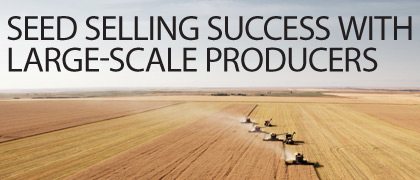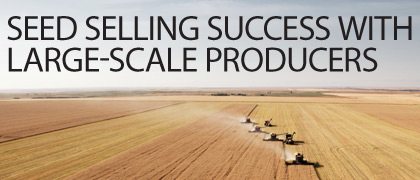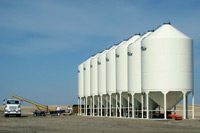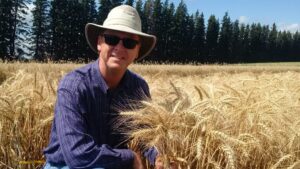
How the rise of large-scale operations will affect the sale and distribution of seed and ways seed sellers can effectively market to this ever-growing group.
According to the 2011 Census of Agriculture, the average farm size in Canada has increased by 6.9 per cent since 2006. The number of farms earning $1 million or more in gross farm receipts reported for 2010 has also increased, growing by 31.2 per cent over the last intercensal period, and just 15 per cent of farms generate almost 70 per cent of total farm revenue in Canada.
According to a report entitled Canadian Farms Becoming Larger with Greater Capital Investment by the George Morris Centre, a not-for-profit economic research institute, this trend will continue due to the following factors:
• Technology has allowed individuals to handle more and larger amounts of product.
• Due to technology, work is less mundane, and more people are attracted to this type of work and business.
• There are economies of size available to the larger operator.
• End users are demanding a consistent product with specific attributes, and it is easiest to deal with fewer growers who can provide the exact product consumers are looking for.
Although the average farmer in Canada is approximately 55 years of age, the younger generation is still involved in major management roles on the farm. The one way for farm families to be successful and generate income to support multiple families is to expand their acreage. What does this mean for seed companies and retailers alike? For example, could this change the way seed is distributed and sold, and what effect will this have on the current marketing channel?
|
The SeedNet collective services a larger area and customer base. |
Localized Distribution Centres
Over the past decade, the way canola is distributed has changed from 50-pound bags purchased from local retailers to bulk boxes and mini-bulk bags shipped directly from seed company distribution centres. Rod Merryweather, president of CRMW Consulting, a company that specializes in consulting with the seed industry on sales and marketing strategies, believes we will see these types of changes within other large markets, such as cereals and pulses. However, given that farmers require large volumes of seed on a daily basis during the planting season, the centralized distribution centres used to distribute canola will not work for these crops.
This opens up room for seed growers and seed companies to set up localized cereal and pulse processing and distribution centres, says Merryweather. The farm supply outlet may continue to sell seed, but distribution will come directly from a local seed farm. As the cereal industry evolves, food companies may demand products that have specific attributes, and with that, local processing of seed will become necessary to ensure quality and consistency. Merryweather says we will see more and more seed growers investing in processing equipment and facilities that will provide the volume of seed that these large-scale producers require and demand.
An organization called SeedNet, established in 2010 by 14 growers in southern Alberta, is already starting to follow this model. The organization was created as a way to sustain the independent family-owned seed supply chain by allowing the collective group to service a larger area and customer base. It also allows the members to speak as a larger group and voice within the industry.
John Crooymans, of Tony Crooymans and Sons, and a member of SeedNet, says the shift to larger farms is a natural evolution because of the demographics of farming. “In this day and age, there are still not enough family successors wanting an existing farm—it tends to get rented or bought up by a larger farm, and first-generation farmers, in this part of the country, are at very best, rare,” he says.
Patrick Fabian, of Fabian Seed Farms Inc., has found that as farms become larger, he can’t always fill the orders. “Larger operations are an agricultural fact of life, and the numbers are continually increasing. Being a member of SeedNet has allowed me to begin to sell to these larger operations, as SeedNet can facilitate these orders by way of sourcing from all the members,” says Fabian. “This allows the large operations to source their seed from one place, rather than having to call all over the region to source from multiple suppliers—one-stop shopping, so to speak. SeedNet allows me to tap into this market, while being able to service the smaller clients as well.”
Large-scale producers often make decisions quickly and concisely, and in order to serve these growers the seed seller often needs to think the same way. “As [growers] become larger they know what they want and have a definite plan for their cropping rotations. The growers succeeding now are smart and precise in their plans and production, requiring us to be the same way in the way we sell and market to them,” says Greg Stamp of Stamp Seed Farms.
John Huvenaars of Huvenaars Seed Farms agrees. “Anyone farming today, regardless of size, are good farmers. If there is anything that characterizes large farms, it would be they are more efficient at decision making. They are booking early to ensure they get the varieties they want, and quality and serviceability are of utmost importance to them,” he says.
Foster Relationships
Often, large- and small-scale producers get their input needs as well as agronomic advice from their local retailers. This trend is continuing; however, a growing number of seed companies now have direct contact with growers. According to Merryweather, the relationship between seed companies and large-scale growers will expand and evolve further.
He suggests seed companies foster these relationships with large-scale producers by providing valuable growing advice, which will go a long way in keeping the producer happy, and result in continued business. “Seed companies should want to ensure that the grower is realizing maximum value from the product,” says Merryweather.
He also says the retailer is a vital part of the selling and distributing process. Seed companies and retailers need to work together to best serve all customers, big and small. The seed company’s role is to provide important agronomic advice as it pertains to the seed they sell, while the retailer provides the whole agronomic package to the farmer, says Merryweather. In the case of small-scale growers, the retailer will likely be their main resource for all of their agronomic needs, including the seed they purchase.
“Most of the seed companies will be focusing their efforts on the big players, and this may provide an opportunity for a company to spend its efforts on these small, often ignored, groups.”
—Al Mussell
Al Mussell, senior research associate at the George Morris Centre, says retailers and seed companies may also find niche markets within the small grower group by focusing their marketing and selling efforts on these growers. “Most of the seed companies will be focusing their efforts on the big players, and this may provide an opportunity for a company to spend its efforts on these small, often ignored, groups,” he says.
Future of Farming
Does an increase in large corporate farms mean we are seeing the demise of the family farm? According to Mussell, this is not the case. “There are ways to be successful with both small and large farms. You can grow the size of your farm or find a high-value crop and maximize profitability that way. Off-farm income will always come into play as well, which will help keep that smaller- to medium-sized farmer in business for the long term,” he says.
Successful seed companies must continue to develop unique ways of meeting the needs of their customers. Large operations are a fact of life in Canadian agriculture and these farmers have different expectations and requirements than smaller operations. According to Merryweather, a seed company that can promote the agronomic value of the seed they sell and effectively offer advice on best seeding practices in order to achieve maximum results will have a lot of success within this market group.
Jennifer Ewankiw














